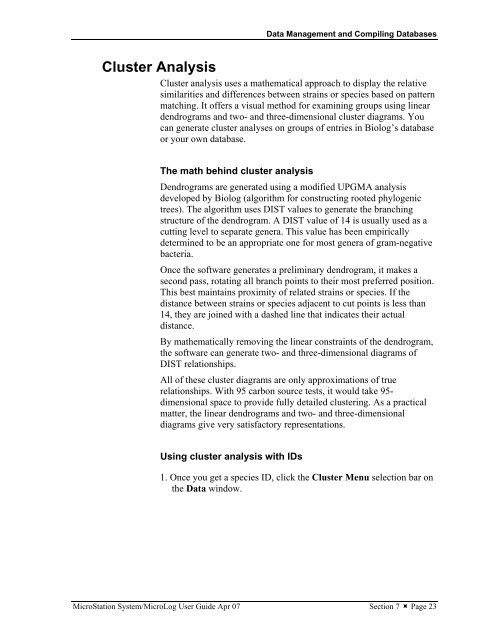MicroStation System, MicroLog Version 4.2 - DTU Systems Biology ...
MicroStation System, MicroLog Version 4.2 - DTU Systems Biology ...
MicroStation System, MicroLog Version 4.2 - DTU Systems Biology ...
You also want an ePaper? Increase the reach of your titles
YUMPU automatically turns print PDFs into web optimized ePapers that Google loves.
Data Management and Compiling Databases<br />
Cluster Analysis<br />
Cluster analysis uses a mathematical approach to display the relative<br />
similarities and differences between strains or species based on pattern<br />
matching. It offers a visual method for examining groups using linear<br />
dendrograms and two- and three-dimensional cluster diagrams. You<br />
can generate cluster analyses on groups of entries in Biolog’s database<br />
or your own database.<br />
The math behind cluster analysis<br />
Dendrograms are generated using a modified UPGMA analysis<br />
developed by Biolog (algorithm for constructing rooted phylogenic<br />
trees). The algorithm uses DIST values to generate the branching<br />
structure of the dendrogram. A DIST value of 14 is usually used as a<br />
cutting level to separate genera. This value has been empirically<br />
determined to be an appropriate one for most genera of gram-negative<br />
bacteria.<br />
Once the software generates a preliminary dendrogram, it makes a<br />
second pass, rotating all branch points to their most preferred position.<br />
This best maintains proximity of related strains or species. If the<br />
distance between strains or species adjacent to cut points is less than<br />
14, they are joined with a dashed line that indicates their actual<br />
distance.<br />
By mathematically removing the linear constraints of the dendrogram,<br />
the software can generate two- and three-dimensional diagrams of<br />
DIST relationships.<br />
All of these cluster diagrams are only approximations of true<br />
relationships. With 95 carbon source tests, it would take 95dimensional<br />
space to provide fully detailed clustering. As a practical<br />
matter, the linear dendrograms and two- and three-dimensional<br />
diagrams give very satisfactory representations.<br />
Using cluster analysis with IDs<br />
1. Once you get a species ID, click the Cluster Menu selection bar on<br />
the Data window.<br />
<strong>MicroStation</strong> <strong>System</strong>/<strong>MicroLog</strong> User Guide Apr 07 Section 7 � Page 23


